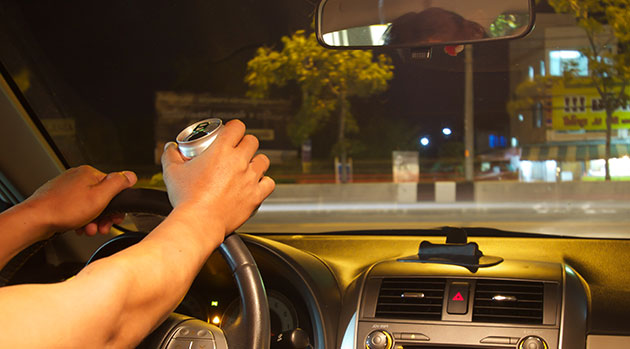As legal marijuana has swept across the nation, there’s been a flurry of discussion on how to enforce the expected rise of DW-Highs. But despite a decades-long jumpstart on dealing with alcohol-based crashes and immense efforts in the public and private sectors to raise awareness on the dangers of drunk driving, the country still has an issue with DWI.
Drunk driving was responsible for the deaths of 10,497 people in 2016, the most recent year for which data are available, according to the National Highway Traffic Safety Administration. The figure makes up 28% of the total roadway deaths that year—which came to 37,461—and marks a 1.7% rise from the number of drunk driving deaths in 2015.
All told, more motorists were killed in alcohol-related accidents than any other type of fatal crash in 2016.
In the wake of those tragic figures has come a 520-page report issued by a panel of top thinkers at the National Academies of Sciences, Engineering, and Medicine, filled with suggestions on how to combat the issue in hopes of never repeating such grisly statistics again.
While likely to draw the ire of the restaurant and alcohol industries, the ideas could possibly help the country reduce the amount of intoxicated driving on American roads.
How Low Can You Go?
Perhaps the report’s biggest bombshell is the suggestion of lowering the blood alcohol concentration (BAC) threshold—the level at which one is considered legally drunk—from 0.08 to 0.05. (States set their own BAC limits, but currently, the 0.08 figure is in play nationwide.)
Drivers with a BAC of 0.05-0.079 were found to be anywhere from 7 to 21 times more likely to be killed in a crash than a motorist with no alcohol in their system.
The idea has long been a recommendation of the federal government, which conducted several prominent studies on the subject on behalf of the National Transportation Safety Board.
That research showed that virtually all drivers experience some level of impairment affecting at least part of their driving performance at the 0.05 mark, with the risks of being involved in an accident significantly increasing at that point. Drivers with a BAC of 0.05-0.079 were found to be anywhere from 7 to 21 times more likely to be killed in a crash than a motorist with no alcohol in their system.
Other reports conducted around the world have shown that lowering the BAC from 0.08 to 0.05 could decrease the number of fatalities and other injuries suffered in drunk driving accidents by anywhere from 5%-8%, and even as much as 18%.
Pinpointing where most people hit the 0.05 mark is difficult and dependent on a number of factors, but it roughly calculates to 4 drinks for a 170-pound male and 3 drinks for a 137-pound female over the course of 2 hours, according to the National Institutes of Health.
The arguments were persuasive enough for Utah, the first state to officially break away from the 0.08 limit. In legislation passed last year, the Beehive State moved to lower the BAC threshold to 0.05 starting December 30, 2018.
But that news wasn’t welcome everywhere—especially in Washington, D.C., where the powerful American Beverage Institute, which lobbies on behalf of the restaurant and hospitality industries, released a statement condemning the move, saying it targeted and punished “moderate, responsible” drinkers.
Still, the ABI is likely even less happy about other suggestions made in the report.
Get What You Pay For
In another push to give states greater control over alcohol consumption, the report suggests instituting a significant increase in taxes on the substance.
The idea, according to the report, is to nip the problem in the bud by hitting consumers where they hurt most: the wallet.
Citing a number of different studies, the report argues that higher alcohol taxes could directly curb alcohol consumption generally and binge drinking specifically, with a particularly potent effect on habitual drinkers who are more likely to suffer from an increased price.
Stymieing that subset would be an especially big step toward curbing drunk driving incidents, the report states, as self-identified binge drinkers have been found responsible for 88% of impaired driving episodes, with 12% reporting they’ve gotten behind the wheel after a binge drinking session, which included, on average, the consumption of 8 drinks within 2 hours.
On top of making alcohol more expensive, the panel suggests making it more difficult to come by at all. The report suggests not only limiting happy hours and other popular drink specials broadly applied at bars in nearly every state, but imposing restrictions on the days and hours the substance can be sold at local liquor stores.
Instead, it says states should focus on reducing illegal alcohol sales and boost funding—perhaps fueled by higher alcohol taxes—for programs supporting minimum legal drinking age laws.
Money should also be redirected to the world of marketing, in order to combat the exposure young people get to all manner of alcohol ads, the committee suggests. The report implores the federal government to use its reach in order to maximize advertising limitations to their fullest potential—including imposing rules that would limit alcohol purveyors from advertising on any forum where the audience of 12-20-year olds is expected to be higher than 15%.
Still, for all its suggestions, the panel failed to recognize what may be the ultimate end to drunk driving incidents: the rise of autonomous cars.
